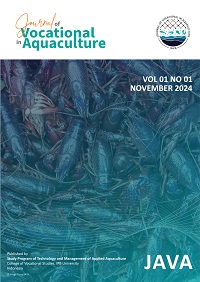Pathogenicity test of Vibrio parahaemolyticus in Pacific white shrimp Penaeus vannamei
Abstract
One of the common diseases affecting the Pacific white shrimp (Penaeus vannamei) culture is vibriosis, caused by infection with Vibrio species, including Vibrio parahaemolyticus. Certain strains of V. parahaemolyticus that carry the PirA and PirB toxins are responsible for causing acute hepatopancreatic necrosis disease (AHPND). This study aimed to assess the pathogenicity of V. parahaemolyticus in P. vannamei using bacterial isolates from different sources. A challenge test was conducted using P. vannamei with an average weight of 0.9±0.1 g, exposed to bacterial concentrations of 104 CFU/mL, as determined by lethal concentration 50% (LC50). The experiment followed a completely randomized design with three treatments and three replicates: a control group (K) of uninfected shrimp, shrimp infected with V. parahaemolyticus from Tasikmalaya, West Java (Vp-1), and shrimp infected with V. parahaemolyticus from Situbondo, East Java (Vp-2). Parameters observed included the confirmation of V. parahaemolyticus and AHPND via polymerase chain reaction (PCR), mortality rate, clinical symptoms, bacterial load, and immune response indicators, including total haemocyte count, phagocytic activity, respiratory burst, phenoloxidase activity, and histopathological examination of the hepatopancreas and intestines. Both Vp-1 and Vp-2 isolates were identified as V. parahaemolyticus AHPND strains, infecting shrimp with clinical signs such as pale hepatopancreas, empty intestines, and lethargic movement. Tissue damage, including extensive necrosis in the hepatopancreas and intestines, was observed, leading to mortality rates of 73.33-81.67% with an average time to death ranging from 24.28 to 65.44 hours postinfection.











